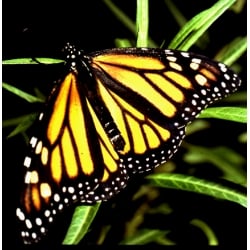- Current EGGS and LARVAE (54)
- EXOTIC BUTTERFLY PUPAE (11)
- MARKET STALL Everything a BARGAIN! (22)
- XXP super fast EXPRESS COURIER DELIVERY (2)
- CURRENT PUPAE - Chrysalides and cocoons (45)
- SILKWORM EGGS and Silkworms (6)
- SPRING and SUMMER EGGS and LARVAE Order now for supply in season (73)
- SPRING and SUMMER PUPAE You can order these NOW in advance (25)
- GIFT SUGGESTIONS (29)
- WINTER PUPAE for breeding in the following season (30)
- CAGES (10)
- PHASMIDS Leaf & Stick Insects, Mantids and more (2)
- SCHOOLS Recommended Livestock (14)
- SLEEVES for REARING LARVAE (7)
- PLASTIC REARING CONTAINERS (2)
- EQUIPMENT (29)
- MOTH TRAPS (7)
- NETTING (3)
- BOOKS (39)
- CHARTS (21)
- SPECIMENS for collectors (151)
- SILK Yarn, Fibres, Silkworm eggs (7)
Monarch Butterfly (Milkweed) Danaus plexippus
This butterfly is officially on the British List, migrating to Britain on rare occasions, from islands off North Africa, and reportedly even from North America. Much larger than any other species on the list, this striking butterfly has powerful, yet graceful flight.
Pupae are received most months spring to autumn, not to any specific date.
The butterflies will emerge from the pupa in warm, moist conditions. This can be done at little over normal room temperature. They like 25-30 degrees C and will breed at these temperatures.
The butterflies like a warm greenhouse containing nectar plants, and this is the best place also for the emerging cage for the pupae. Shade the cage from direct sun which is too harsh.
The only larval foodplants are Milkweeds Asclepias and Silkweed Gomphocarpus, both of which grow well from seed. Asclepias seeds and even plants can be found on the internet. Gomphocarpus plants are advertised by http://www.curiousplants.co.uk/fur-balls-plant-asclepias-physocarpa-or-gomphocarpus-physocarpus-126-p.asp
Asclepias curassavica is an indoor plant, not frost-hardy, that grows fast and is excellent as a foodplant throughout the year in a greenhouse. There are hardy herbacious species (unsuitable for winter rearing). The most prolific for feeding quantities of larvae is Asclepias syriaca with multiple broad leaves and stems a metre or more high.
Beware: don't under-estimate the voracious appetite of larvae! Grow plenty of foodplant. The larvae and adults are strikingly marked with warning colours to deter predators, and they contain toxins from the foodplant that reinforce the warning! Several generations are produced each summer.
In the wild, the adults migrate south to warmer climate, where they hibernate in huge numbers, covering whole trees, like autumn leaves. The pupa is like a miniature Christmas tree bauble! Even if you do not have the foodplants to raise larvae, the emergence of the butterflies in your own emerging cage is a great experience.






